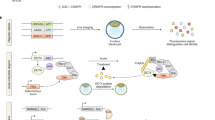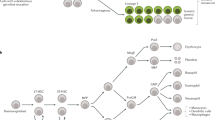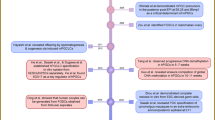Abstract
Monogenic disorders occur at a high frequency in human populations and are commonly inherited through the germline. Unfortunately, once the mutation has been transmitted to a child, only limited treatment options are available in most cases. However, means of correcting disease-causing nuclear and mitochondrial DNA mutations in gametes or preimplantation embryos have now been developed and are commonly referred to as germline gene therapy (GGT). We will discuss these novel strategies and provide a path forward for safe, high-efficiency GGT that may provide a promising new paradigm for preventing the passage of deleterious genes from parent to child.
This is a preview of subscription content, access via your institution
Access options
Access Nature and 54 other Nature Portfolio journals
Get Nature+, our best-value online-access subscription
$29.99 / 30 days
cancel any time
Subscribe to this journal
Receive 12 print issues and online access
$209.00 per year
only $17.42 per issue
Buy this article
- Purchase on Springer Link
- Instant access to full article PDF
Prices may be subject to local taxes which are calculated during checkout



Similar content being viewed by others
References
Genes and Human Disease (World Health Organization); https://www.who.int/genomics/public/geneticdiseases/en/index2.html.
Cornu, T. I., Mussolino, C. & Cathomen, T. Refining strategies to translate genome editing to the clinic. Nat. Med. 23, 415–423 (2017).
Rossidis, A. C. et al. In utero CRISPR-mediated therapeutic editing of metabolic genes. Nat. Med. 24, 1513–1518 (2018).
Massaro, G. et al. Fetal gene therapy for neurodegenerative disease of infants. Nat. Med. 24, 1317–1323 (2018).
Genovese, P. et al. Targeted genome editing in human repopulating haematopoietic stem cells. Nature 510, 235–240 (2014).
Koch, L. Genetic engineering: in vivo genome editing — growing in strength. Nat. Rev. Genet. 17, 124 (2016).
Liu, R. et al. Homozygous defect in HIV-1 coreceptor accounts for resistance of some multiply-exposed individuals to HIV-1 infection. Cell 86, 367–377 (1996).
Haworth, K. G., Peterson, C. W. & Kiem, H. P. CCR5-edited gene therapies for HIV cure: Closing the door to viral entry. Cytotherapy 19, 1325–1338 (2017).
Tebas, P. et al. Gene editing of CCR5 in autologous CD4 T cells of persons infected with HIV. N. Engl. J. Med. 370, 901–910 (2014).
Cyranoski, D. First CRISPR babies: six questions that remain. Nature (2 December 2018).
Carlson, L. M. & Vora, N. L. Prenatal diagnosis: screening and diagnostic tools. Obstet. Gynecol. Clin. North Am. 44, 245–256 (2017).
Handyside, A. H., Kontogianni, E. H., Hardy, K. & Winston, R. M. Pregnancies from biopsied human preimplantation embryos sexed by Y-specific DNA amplification. Nature 344, 768–770 (1990).
Lee, V. C. Y., Chow, J. F. C., Yeung, W. S. B. & Ho, P. C. Preimplantation genetic diagnosis for monogenic diseases. Best. Pract. Res. Clin. Obstet. Gynaecol. 44, 68–75 (2017).
2016 IVF Outcomes Per Egg Retrieval Cycle (Society for Assisted Reproductive Technology (SART), 2016); https://www.sartcorsonline.com/rptCSR_PublicMultYear.aspx?ClinicPKID=0
Steffann, J., Jouannet, P., Bonnefont, J. P., Chneiweiss, H. & Frydman, N. Could failure in preimplantation genetic diagnosis justify editing the human embryo genome? Cell Stem Cell 22, 481–482 (2018).
Mitalipov, S., Amato, P., Parry, S. & Falk, M. J. Limitations of preimplantation genetic diagnosis for mitochondrial DNA diseases. Cell Rep. 7, 935–937 (2014).
Wolf, D. P., Mitalipov, N. & Mitalipov, S. Mitochondrial replacement therapy in reproductive medicine. Trends Mol. Med. 21, 68–76 (2015).
Tachibana, M. et al. Mitochondrial gene replacement in primate offspring and embryonic stem cells. Nature 461, 367–372 (2009).
Ma, H. et al. Functional human oocytes generated by transfer of polar body genomes. Cell Stem Cell 20, 112–119 (2017).
Craven, L. et al. Pronuclear transfer in human embryos to prevent transmission of mitochondrial DNA disease. Nature 465, 82–85 (2010).
Lee, H. S. et al. Rapid mitochondrial DNA segregation in primate preimplantation embryos precedes somatic and germline bottleneck. Cell Rep. 1, 506–515 (2012).
Tachibana, M. et al. Towards germline gene therapy of inherited mitochondrial diseases. Nature 493, 627–631 (2013).
Kang, E. et al. Mitochondrial replacement in human oocytes carrying pathogenic mitochondrial DNA mutations. Nature 540, 270–275 (2016).
Paull, D. et al. Nuclear genome transfer in human oocytes eliminates mitochondrial DNA variants. Nature 493, 632–637 (2013).
HFEA. HFEA statement on mitochondrial donation. https://www.hfea.gov.uk/about-us/news-and-press-releases/2017-news-and-press-releases/hfea-statement-on-mitochondrial-donation/ (2017).
Alikani, M., Fauser, B. C. J., Garcia-Valesco, J. A., Simpson, J. L. & Johnson, M. H. First birth following spindle transfer for mitochondrial replacement therapy: hope and trepidation. Reprod. Biomed. Online 34, 333–336 (2017).
Adashi, E. Y. & Cohen, I. G. Preventing mitochondrial disease: a path forward. Obstet. Gynecol. 131, 553–556 (2018).
Wolf, D. P., Hayama, T. & Mitalipov, S. Mitochondrial genome inheritance and replacement in the human germline. EMBO J. 36, 2659 (2017).
Gammage, P. A. et al. Genome editing in mitochondria corrects a pathogenic mtDNA mutation in vivo. Nat. Med. 24, 1691–1695 (2018).
Bacman, S. R. et al. MitoTALEN reduces mutant mtDNA load and restores tRNA(Ala) levels in a mouse model of heteroplasmic mtDNA mutation. Nat. Med. 24, 1696–1700 (2018).
Reddy, P. et al. Selective elimination of mitochondrial mutations in the germline by genome editing. Cell 161, 459–469 (2015).
Yusa, K. et al. Targeted gene correction of alpha1-antitrypsin deficiency in induced pluripotent stem cells. Nature 478, 391–394 (2011).
Suzuki, K. et al. Targeted gene correction minimally impacts whole-genome mutational load in human-disease-specific induced pluripotent stem cell clones. Cell Stem Cell 15, 31–36 (2014).
Schwank, G. et al. Functional repair of CFTR by CRISPR/Cas9 in intestinal stem cell organoids of cystic fibrosis patients. Cell Stem Cell 13, 653–658 (2013).
Kowalczykowski, S. C. An overview of the molecular mechanisms of recombinational DNA repair. Cold Spring Harb. Perspect. Biol. 7, a016410 (2015).
Spies, M. & Fishel, R. Mismatch repair during homologous and homeologous recombination. Cold Spring Harb. Perspect. Biol. 7, a022657 (2015).
Kosicki, M., Tomberg, K. & Bradley, A. Repair of double-strand breaks induced by CRISPR–Cas9 leads to large deletions and complex rearrangements. Nat. Biotechnol. 36, 765–771 (2018).
Richardson, C. D., Ray, G. J., DeWitt, M. A., Curie, G. L. & Corn, J. E. Enhancing homology-directed genome editing by catalytically active and inactive CRISPR–Cas9 using asymmetric donor DNA. Nat. Biotechnol. 34, 339–344 (2016).
Doudna, J. A. & Charpentier, E., Genome editing. The new frontier of genome engineering with CRISPR–Cas9. Science 346, 1258096 (2014).
Chen, J. M., Cooper, D. N., Chuzhanova, N., Ferec, C. & Patrinos, G. P. Gene conversion: mechanisms, evolution and human disease. Nat. Rev. Genet. 8, 762–775 (2007).
Ma, H. et al. Correction of a pathogenic gene mutation in human embryos. Nature 548, 413–419 (2017).
Cho, S. W., Kim, S., Kim, J. M. & Kim, J. S. Targeted genome engineering in human cells with the Cas9 RNA-guided endonuclease. Nat. Biotechnol. 31, 230–232 (2013).
Kim, H. & Kim, J. S. A guide to genome engineering with programmable nucleases. Nat. Rev. Genet. 15, 321–334 (2014).
Jinek, M. et al. A programmable dual-RNA-guided DNA endonuclease in adaptive bacterial immunity. Science 337, 816–821 (2012).
Ma, H. et al. Ma et al. reply. Nature 560, E10–E23 (2018).
Egli, D. et al. Inter-homologue repair in fertilized human eggs? Nature 560, E5–E7 (2018).
Adikusuma, F. et al. Large deletions induced by Cas9 cleavage. Nature 560, E8–E9 (2018).
Matsoukas, I. G. Commentary: programmable base editing of A.T to G.C in genomic DNA without DNA cleavage. Front. Genet. 9, 21 (2018).
Komor, A. C., Kim, Y. B., Packer, M. S., Zuris, J. A. & Liu, D. R. Programmable editing of a target base in genomic DNA without double-stranded DNA cleavage. Nature 533, 420–424 (2016).
Gaudelli, N. M. et al. Programmable base editing of A*T to G*C in genomic DNA without DNA cleavage. Nature 551, 464–471 (2017).
Jin, S. et al. Cytosine, but not adenine, base editors induce genome-wide off-target mutations in rice. Science 364, 292–295 (2019).
Fu, Y. et al. High-frequency off-target mutagenesis induced by CRISPR–Cas nucleases in human cells. Nat. Biotechnol. 31, 822–826 (2013).
Hsu, P. D. et al. DNA targeting specificity of RNA-guided Cas9 nucleases. Nat. Biotechnol. 31, 827–832 (2013).
Cho, S. W. et al. Analysis of off-target effects of CRISPR/Cas-derived RNA-guided endonucleases and nickases. Genome Res. 24, 132–141 (2014).
Mali, P. et al. RNA-guided human genome engineering via Cas9. Science 339, 823–826 (2013).
Hsu, P. D., Lander, E. S. & Zhang, F. Development and applications of CRISPR–Cas9 for genome engineering. Cell 157, 1262–1278 (2014).
Kim, D. et al. Digenome-seq: genome-wide profiling of CRISPR-Cas9 off-target effects in human cells. Nat. Methods 12, 237–243 (2015).
Kim, D., Kim, S., Kim, S., Park, J. & Kim, J. S. Genome-wide target specificities of CRISPR–Cas9 nucleases revealed by multiplex Digenome-seq. Genome Res. 26, 406–415 (2016).
Kim, S., Kim, D., Cho, S. W., Kim, J. & Kim, J. S. Highly efficient RNA-guided genome editing in human cells via delivery of purified Cas9 ribonucleoproteins. Genome Res. 24, 1012–1019 (2014).
Varga, T. & Aplan, P. D. Chromosomal aberrations induced by double strand DNA breaks. DNA Repair (Amst.) 4, 1038–1046 (2005).
Yoshimi, K., Kaneko, T., Voigt, B. & Mashimo, T. Allele-specific genome editing and correction of disease-associated phenotypes in rats using the CRISPR–Cas platform. Nat. Commun. 5, 4240 (2014).
Ihry, R. J. et al. p53 inhibits CRISPR–Cas9 engineering in human pluripotent stem cells. Nat. Med. 24, 939–946 (2018).
Haapaniemi, E., Botla, S., Persson, J., Schmierer, B. & Taipale, J. CRISPR–Cas9 genome editing induces a p53-mediated DNA damage response. Nat. Med. 24, 927–930 (2018).
Tang, L. et al. CRISPR/Cas9-mediated gene editing in human zygotes using Cas9 protein. Mol. Genet. Genom. 292, 525–533 (2017).
Liang, P. et al. CRISPR/Cas9-mediated gene editing in human tripronuclear zygotes. Protein Cell 6, 363–372 (2015).
Tu, Z. et al. Promoting Cas9 degradation reduces mosaic mutations in non-human primate embryos. Sci. Rep. 7, 42081 (2017).
Hashimoto, M., Yamashita, Y. & Takemoto, T. Electroporation of Cas9 protein/sgRNA into early pronuclear zygotes generates non-mosaic mutants in the mouse. Dev. Biol. 418, 1–9 (2016).
Song, J. et al. RS-1 enhances CRISPR/Cas9- and TALEN-mediated knock-in efficiency. Nat. Commun. 7, 10548 (2016).
Wilde, J.J. et al. RAD51 enhances zygotic interhomolog repair. Preprint at https://doi.org/10.1101/263699 (2018).
Chan, S. et al. Genome editing technologies and human germline genetic modification: the hinxton group consensus statement. Am. J. Bioeth. 15, 42–47 (2015).
Human Genome Editing: Science, Ethics, and Governance (The National Academies Press, 2017).
Ormond, K. E. et al. Human germline genome editing. Am. J. Hum. Genet. 101, 167–176 (2017).
Genome Editing and Human Reproduction: Social and Ethical Issues (Nuffield Council on Bioethics, 2018).
Lander, E. S. et al. Adopt a moratorium on heritable genome editing. Nature 567, 165–168 (2019).
Ishii, T. The ethics of creating genetically modified children using genome editing. Curr. Opin. Endocrinol. Diabetes Obes. 24, 418–423 (2017).
Cohen, J. An ‘epic scientific misadventure’: NIH head Francis Collins ponders fallout from CRISPR baby study. Science (30 November 2018).
Scheufele, D. A. et al. U.S. attitudes on human genome editing. Science 357, 553–554 (2017).
McCaughey, T. et al. A global social media survey of attitudes to human genome editing. Cell Stem Cell 18, 569–572 (2016).
Ishii, T. Reproductive medicine involving mitochondrial dna modification: evolution, legality, and ethics. EMJ Repro. Health 4, 88–99 (2018).
O’Sullivan, B. P. & Freedman, S. D. Cystic fibrosis. Lancet 373, 1891–1904 (2009).
US National Library of Medicine. Tay–Sachs disease https://ghr.nlm.nih.gov/condition/tay-sachs-disease (2018).
National Institute of Neurological Disorders and Stroke. Huntington’s disease information page https://www.ninds.nih.gov/Disorders/All-Disorders/Huntingtons-Disease-Information-Page (2016).
National Heart, Lung, and Blood Institute. Marfan Syndrome https://www.nhlbi.nih.gov/health-topics/marfan-syndrome (2019).
Petrucelli, N., Daly, M. B. & Pal, T. in GeneReviews (eds Adam, M. P. et al.) (University of Washington, 1998).
National Eye Institute. Color blindness https://nei.nih.gov/health/color_blindness (2015).
Wallace, D. C. & Chalkia, D. Mitochondrial DNA genetics and the heteroplasmy conundrum in evolution and disease. Cold Spring Harb. Perspect. Biol. 5, a021220 (2013).
U.S. National Library of Medicine. Leigh syndrome https://ghr.nlm.nih.gov/condition/leigh-syndrome (2018).
Wallace, D. C. et al. Mitochondrial DNA mutation associated with Leber’s hereditary optic neuropathy. Science 242, 1427–1430 (1988).
Galanello, R. & Origa, R. Beta-thalassemia. Orphanet J. Rare Dis. 5, 11 (2010).
U.S. National Library of Medicine. Beta thalassemia https://ghr.nlm.nih.gov/condition/beta-thalassemia (2015).
U.S. National Library of Medicine. Spinal muscular atrophy https://ghr.nlm.nih.gov/condition/spinal-muscular-atrophy (2018).
Davies, J. C., Alton, E. W. & Bush, A. Cystic fibrosis. Br. Med. J. 335, 1255–1259 (2007).
Ratjen, F. & Doring, G. Cystic fibrosis. Lancet 361, 681–689 (2003).
Sosnay, P. R. et al. Defining the disease liability of variants in the cystic fibrosis transmembrane conductance regulator gene. Nat. Genet. 45, 1160–1167 (2013).
Author information
Authors and Affiliations
Corresponding author
Ethics declarations
Competing interests
S.M. is a co-founder and shareholder of Mitogenome Therapeutics, Inc. The other authors declare no competing financial interests
Additional information
Publisher’s note: Springer Nature remains neutral with regard to jurisdictional claims in published maps and institutional affiliations.
Rights and permissions
About this article
Cite this article
Wolf, D.P., Mitalipov, P.A. & Mitalipov, S.M. Principles of and strategies for germline gene therapy. Nat Med 25, 890–897 (2019). https://doi.org/10.1038/s41591-019-0473-8
Received:
Accepted:
Published:
Issue Date:
DOI: https://doi.org/10.1038/s41591-019-0473-8
This article is cited by
-
Developing hydrogels for gene therapy and tissue engineering
Journal of Nanobiotechnology (2024)
-
Developmental progression of DNA double-strand break repair deciphered by a single-allele resolution mutation classifier
Nature Communications (2024)
-
Molecular basis for maternal inheritance of human mitochondrial DNA
Nature Genetics (2023)
-
Initial heritable genome editing: mapping a responsible pathway from basic research to the clinic
Medicine, Health Care and Philosophy (2023)
-
Transdermal delivery for gene therapy
Drug Delivery and Translational Research (2022)



